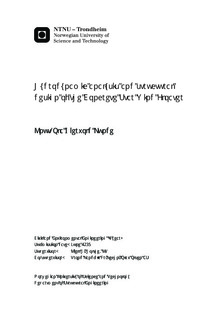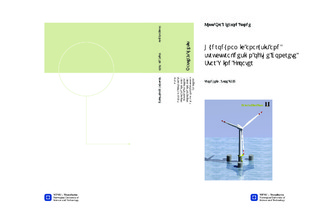| dc.description.abstract | This thesis was initiated by Trond Landbø from Dr.techn. Olav Olsen after an internship there during the summer of 2012. Amongst other projects, Dr.techn. Olav Olsen works with different concepts for floating concrete hulls to support wind turbines in deep seas. They have a patented structural concept under development which inspired this master thesis.
The main goal of this thesis was to modify the design of the basic concept to fulfill requirements with respect to higher natural periods in heave, pitch and roll. To reach this goal, calculations made by hand and analysis in Wadam were to be used. Another aim was to utilize a new IFE-program, called 3DFloat, to gain experience of the new software that?s under development. The design criteria for the natural periods were set to at least 20 seconds in heave and 25 seconds in pitch/roll, with a distance of 4-6 seconds between the periods.
The first part of the work was a literature study into hydrodynamics and hydrostatics, and also how to use the two computational tools needed for the analysis.
Once the setup-phase was completed, calculations of the basic concept were made. The basic concept was given as input to this thesis and calculations were therefore made to allow for a comparison with that of Dr.techn. Olav Olsen and thus explore whether the methods for calculation and analysis were correct. The results matched, with natural periods on 15.9 seconds in heave and 22.5 in pitch/roll for the basic concept.
The second phase of the design was to alter the outer geometries and examine the effects of different parameters on the natural periods. This thesis chose to study five parameters of the outer geometry. Through the use of hand calculations and Wadam, the necessary outer geometry was found with natural periods over the criteria. Graphs depicting the increase/decrease in concrete volumes as a result of changing the parameters were also added as a way to monitor the effects such changes have on cost.
Lastly, the final concept was adjusted with regards to the wall thickness and concrete volumes, before it was modeled and analyzed. Natural periods were found to be 21.5 seconds in heave and 26 seconds in pitch/roll, fulfilling the criteria. Static tilt was calculated at 6.593 degrees, which is was little high, as ideally it should not exceed 6 degrees.
With the help of 3DFloat, a check was made of the forces that would result the wave regime at the intended location of the hull. During this process, it was discovered that 3DFloat calculates all waves with period Tp=10 seconds. Comparing the forces from the waves against the capacity of the hull gave a utilization of below 50% of the hulls capacity.
The use of 3DFloat was very interesting. Modeling of the basic concept was succesful and it behaved as intended, but the final concept did not. This was due to the fact that at present, 3DFloat, is only able to calculate with cylindrical elements. The adaptations required between rectangular elements and conical elements for the final concept therefore seem to have created some problems for 3DFloat that were not solved by the time this thesis was completed. | |

